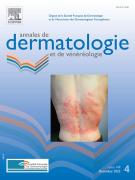Actinomycose fessière - 29/04/08
S. Maradeix [1],
Y. Scrivener [1],
E. Grosshans [1],
X. Sabatier [2],
P. Riegel [3],
B. Cribier [1]
Voir les affiliations| pages | 4 |
| Iconographies | 4 |
| Vidéos | 0 |
| Autres | 0 |
Introduction |
L'actinomycose cutanée fessière est une infection bactérienne granulomateuse rare qui débute généralement en région périanale. Nous présentons le cas exceptionnel d'une forme pseudo-tumorale.
Observation |
Une femme de 69 ans, en bon état général, a développé en trois semaines une masse indurée du quadrant supéro-externe de la fesse droite. La lésion tumorale était centrée par un nodule ulcéré et mesurait une dizaine de centimètres de diamètre. L'imagerie montrait un envahissement des tissus mous de la peau au muscle psoas interne droit dont la tonalité adipeuse était compatible avec un liposarcome. La biopsie cutanée a montré un grain bactérien caractéristique au sein d'un granulome cholestérique. Les cultures tardives en milieu aérobie ont permis d'identifier Actinomyces gerencseriae. La guérison a été obtenue après excision complète des tissus fibrosés et 8 mois d'antibiothérapie par amoxicilline-acide clavulanique.
Discussion |
Outre l'aspect clinique très inhabituel, l'originalité de cette actinomycose fessière repose sur une possible origine appendiculaire, 4 ans après une appendicite aiguë, avec fistulisation lente par voie postérieure. D'autres cas d'actinomycoses d'origine appendiculaire ont été rapportés et la survenue retardée après l'intervention est documentée. L'aspect pseudo-sarcomateux a été responsable d'une errance diagnostique. L'image histologique et dans un second temps le résultat des cultures bactériologiques ont permis le diagnostic.
Actinomycosis of the buttock. |
Introduction |
Cutaneous actinomycosis of the buttocks is a rare granulomatous bacterial infection that usually starts in the perianal area. We present an exceptional case in the form of a pseudo-tumor.
Case report |
A 69 year-old woman, in general good health, developed an indurate mass on the supra-external quadrant of the right buttock. The tumor was centered by an ulcerated nodule with a diameter of around 10 centimeters. Imaging showed invasion of the soft tissue of the skin in the internal psoas muscle, the adipose tonality of which was compatible with a liposarcoma. The skin biopsy revealed characteristic bacterial grain in the center of a cholesterol granuloma. Subsequent culture in aerobic milieu identified Actinomyces gerencseriae. Cure was obtained following complete exeresis of the fibrous tissue and 8 months of antibiotic amoxicillin-clavulanic acid therapy.
Discussion |
Other than the most unusual clinical aspect, the originality of this case of actinomycosis of the buttocks is based on its potential appendix origin, 4 years after acute appendicitis, with slow posterior fistulation. Other cases of actinomycosis of appendix origin have been reported and its delayed onset following the intervention has been documented. The pseudo-sarcomatous aspect was responsible for diagnostic wandering. The histological image and, subsequently, the results of the bacteriological culture confirmed the diagnosis.
Plan
© 2005 Elsevier Masson SAS. Tous droits réservés.
Vol 132 - N° 5
P. 462-465 - mai 2005 Retour au numéroBienvenue sur EM-consulte, la référence des professionnels de santé.
L’accès au texte intégral de cet article nécessite un abonnement.
Bienvenue sur EM-consulte, la référence des professionnels de santé.
L’achat d’article à l’unité est indisponible à l’heure actuelle.
Déjà abonné à cette revue ?

